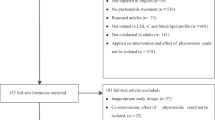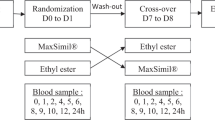Abstract
Objective: To evaluate both efficacy and safety in humans of long-term consumption of spreads containing plant sterol esters.
Design: Randomized double-blind placebo-controlled parallel trial.
Subjects: Hundred and eighty-five healthy volunteers (35–64 y).
Interventions: Volunteers daily consumed 20 g spread enriched with 1.6 g plant sterols as fatty acid esters or a control spread for 1 y. They continued their habitual diet and lifestyle. Outcome measures included efficacy markers such as total and LDL-cholesterol, a large range of safety parameters, and reporting of adverse events.
Results: Consumption of the plant sterol ester-enriched spread consistently lowered total and LDL cholesterol during the 1 y period on average by 4 and 6%, respectively (0.01<P<0.05). Plant sterols intake did on average not result in a lower carotenoid concentration (when expressed per LDL-cholesterol) after 52 weeks (P>0.05). However, carotenoid concentrations changed over time. Plant sterols intake reduced lipid adjusted α- and β-carotene-concentrations by only 15–25% after 1 y, relative to control. Lipid-adjusted fat-soluble vitamin concentrations remained unchanged. Plant sterol concentrations in serum were increased from 2.76 to 5.31 (µmol/mmol total cholesterol) for campesterol (P<0.0001) and from 1.86 to 2.47 (µmol/mmol total cholesterol) for β-sitosterol (P<0.0001). The increase in total plant sterol concentration in red blood cells (5.29–9.62 µg/g) did not affect red blood cell deformability. Hormone levels in males (free and total testosterone) and females (luteinizing hormone, follicle stimulating hormone, β-estradiol and progesterone) as well as all clinical chemical and hematological parameters measured were unaffected. Adverse events reported were not different between subjects consuming control spread and subjects consuming plant sterol esters-enriched spread.
Conclusions: Consumption of a plant sterol esters-enriched spread is an effective way to consistently lower blood cholesterol concentrations and is safe to use over a long period of time.
Sponsorship: Unilever.
This is a preview of subscription content, access via your institution
Access options
Subscribe to this journal
Receive 12 print issues and online access
$259.00 per year
only $21.58 per issue
Buy this article
- Purchase on Springer Link
- Instant access to full article PDF
Prices may be subject to local taxes which are calculated during checkout


Similar content being viewed by others
References
Ayesh, R, Weststrate, JA, Drewitt, PN & Hepburn, PA (1999). Safety evaluation of phytosterol esters. Part 5. Faecal short-chain fatty acid and microflora content, faecal bacterial enzyme activity and serum female sex hormones in healthy normolipidaemic volunteers consuming a controlled diet either with or without a phytosterol ester-enriched margarine. Food Chem. Toxicol., 37, 1127–1138.
Baker, VA, Hepburn, PA, Kennedy, SJ, Jones, PA, Lea, LJ, Sumpter, JP & Ashby, J (1999). Safety evaluation of phytosterol esters: Part 1. Assessment of oestrogenicity using a combination of in vivo and in vitro assays. Food Chem. Toxicol., 37, 13–22.
Blair, SN, Capuzzi, DM, Gottlieb, SO, Nguyen, T, Morgan, JM & Cater, NB (2000). Incremental reduction of serum total cholesterol and low density lipoprotein cholesterol with the addition of plant stanol ester containing spread to statin therapy. Am. J. Cardiol., 86, 46–52.
Denke, MA (1995). Lack of efficacy of low-dose sitostanol therapy as an adjunct to a cholesterol-lowering diet in men with a moderate hypercholesterolemia. Am. J. Clin. Nutr., 61, 392–396.
Friedewald, WT, Levy, RI & Frederickson, DS (1972). Estimation of the concentration of low-density lipoprotein cholesterol in plasma, without use of the preparative ultracentrifuge. Clin. Chem., 18, 499–502.
Grootenhuis, PA, Westenbrink, S, Sie, CMTL, de Neeling, JND, Kok, FJ & Bouter, LM (1995). A semiquantitative food frequency questionnaire for use in epidemiologic research among the elderly: Validation by comparison with dietary history. J. Clin. Epidemiol., 48, 859–868.
Hallikainen, MA & Uusitupa, MI (1999). Effects of 2 low-fat stanol ester-containing margarines on serum cholesterol concentrations as part of a low-fat diet in hypercholesterolemic subjects. Am. J. Clin. Nutr., 69, 403–410.
Hallikainen, MA, Sarkkinen, ES & Uusitupa, MI (1999). Effects of low-fat stanol ester enriched margarines on concentrations of serum carotenoids in subjects with elevated serum cholesterol concentrations. Eur. J. Clin. Nutr., 53, 966–969.
Hallikainen, MA, Sarkkinen, ES & Uusitupa, MI (2000a). Plant stanol esters affect serum cholesterol concentrations of hypercholesterolemic men and women in a dose-dependent manner. J. Nutr., 130, 767–776.
Hallikainen, MA, Sarkkinen, ES, Gylling, H, Erkkila, AT & Uusitupa, MI (2000b). Comparison of the effects of plant sterol ester and plant stanol ester-enriched margarines in lowering serum cholesterol concentrations in hypercholesterolaemic subjects on a low-fat diet. Eur. J. Clin. Nutr., 54, 15–25.
Hardeman, MR, Goedhart, PT, Dobbe, JGG & Lettinga, KP (1994a). Laser-assisted optical rotational cell analyser (LORCA); I. A new instrument for measurement of various structural hemorheological parameters. Clin. Hemorheol., 14, 605–618.
Hardeman, MR, Goedhart, PT & Schut, NH (1994b). Laser-assisted optical rotational cell analyser (LORCA); II. Red cell deformability: elongation index versus cell transit time. Clin. Hemorheol., 14, 619–630.
Hendriks, HFJ, Weststrate, JA, van Vliet, T & Meijer, GW (1999). Spreads enriched with three different levels of vegetable oil sterols and the degree of cholesterol lowering in normocholesterolaemic and mildly hypercholesterolaemic subjects. Eur. J. Clin. Nutr., 53, 319–327.
Hepburn, PA, Homer, SA & Smith, M (1999). Safety evaluation of phytosterol esters: Part 2. Subchronic 90-day oral toxicity study on phytosterol esters: A novel functional food. Food Chem. Toxicol., 37, 521–532.
Jones, PJ, Raeini-Sarjaz, M, Ntanios, FY, Vanstone, CA, Feng, JY & Parsons, WE (2000). Modulation of plasma lipid levels and cholesterol kinetics by phytosterol versus phytostanol esters. J. Lipid Res., 41, 697–705.
Kempen, HJM, de Knijff, P, Boomsma, DI, van der Voort, HA, Gevers Leuven, JA & Havekes, L (1991). Plasma levels of lathosterol and phytosterol in relation to age, sex, anthropometric parameters, plasma lipids, and apolipoprotein E phenotype in 160 Dutch families. Metabolism, 6, 604–611.
Law, MR, Wald, MJ & Thompson, SG (1994). By how much and how quickly does a reduction in serum cholesterol concentrations lower risk of ischaemic heart disease?. Br. Med. J., 308, 367–373.
Miettinen, TA, Puska, P, Gylling, H, Vanhanen, H & Vartiainen, E (1995). Reduction of serum cholesterol with sitostanol-ester margarine in a mildly hypercholesterolemic population. New Engl. J. Med., 333, 1308–1312.
Moghadasian, MH & Frohlich, JJ (1999). Effects of dietary phytosterols on cholesterol metabolism and atherosclerosis: clinical and experimental evidence. Am. J. Med., 107, 588–594.
Nguyen, TT, Dale, LC, von Bergmann, K & Croghan, IT (1999). Cholesterol-lowering effect of stanol ester in a US population of mildly hypercholesterolemic men and women: a randomized controlled trial. Mayo. Clin. Proc., 74, 1198–1206.
Normen, L, Dutta, P, Lia, A & Andersson, H (2000). Soy sterol esters and beta-sitostanol ester as inhibitors of cholesterol absorption in human small bowel. Am. J. Clin. Nutr., 71, 908–913.
Plat, J, van Onselen, EN, van Heugten, MM & Mensink, RP (2000). Effects on serum lipids, lipoproteins and fat soluble antioxidant concentrations of consumption frequency of margarines and shortenings enriched with plant stanol esters. Eur. J. Clin. Nutr., 54, 671–677.
Pollak, OJ & Kritchevsky, D (1981). Monographs in Atherosclerosis, New York: Basel
Sanders, DJ, Minter, HJ, Howes, D & Hepburn, PA (2000). The safety evaluation of phytosterol esters. Part 6. The comparative absorption and tissue distribution of phytosterols in the rat. Food Chem. Toxicol., 38, 485–491.
Sierksma, A, Weststrate, JA & Meijer, GW (1999). Spreads enriched with plant sterols, either esterified 4,4-dimethylsterols or free 4-desmethylsterols, and plasma total- and LDL-cholesterol concentrations. Br. J. Nutr., 82, 273–282.
Stamler, J, Daviglus, ML, Garside, DB, Dyer, AR, Greenland, P & Neaton, JD (2000). Relationship of baseline serum cholesterol levels in 3 large cohorts of younger men to long-term coronary, cardiovascular, and all-cause mortality and to longevity. JAMA, 284, 311–318.
Tammi, A, Ronnemaa, T, Gylling, H, Rask-Nissila, L, Viikari, J, Tuominen, J, Pulkki, K & Simell, O (2000). Plant stanol ester margarine lowers serum total and low-density lipoprotein cholesterol concentrations of healthy children: the STRIP project. J. Pediatr., 136, 503–510.
Tang, JL, Armitage, JM, Lancaster, T, Silagy, CA, Fowler, GH & Neil, HAW (1998). Systematic review of dietary intervention trials to lower blood total cholesterol in free-living subjects. Br. Med. J., 316, 1213–1220.
Vuorio, AF, Gylling, H, Turtola, H, Kontula, K, Ketonen, P & Miettinen, TA (2000). Stanol ester margarine alone and with simvastatin lowers serum cholesterol in families with familial hypercholesterolemia caused by the FH-North Karelia mutation. Arterioscler. Thromb. Vase. Biol., 20, 500–506.
Waalkens-Berendsen, DH, Wolterbeek, APM, Wijnands, MVW, Richold, M & Hepburn, PA (1999). Safety evaluation of phytosterol esters. Part 3. Two-generation reproduction study of phytosterol esters in rats: a novel functional food. Food Chem. Toxicol., 37, 683–696.
Weststrate, JA & Meijer, GW (1998). Plant sterol-enriched margarines and reduction of plasma total- and LDL-cholesterol concentrations in normocholesterolaemic and mildly hypercholesterolaemic subjects. Eur. J. Clin. Nutr., 52, 334–343.
Weststrate, JA, Ayesh, R, Bauer-Plank, C & Drewitt, PN (1999). Safety evaluation of phytosterol esters. Part 4. Faecal concentrations of bile acids and neutral sterols in healthy normolipidaemic volunteers consuming a controlled diet either with or without a phytosterol ester-enriched margarine. Food Chem. Toxicol., 37, 1063–1071.
Acknowledgements
We thank all those involved in the conduct of the study, particularly R Buytenhek, J Catsburg, AJ de Vries, MR Hardeman, and WHJ Vaes for analytical support; K Povey for production of the spreads; and JM Leezer-de Hoog, FW Sieling, I van den Assum-Ziel and WAA Klöpping-Ketelaars, for their effort during the clinical part of the study. We also thank the volunteers for their enthusiastic participation.
Author information
Authors and Affiliations
Contributions
Guarantor: HFJ Hendriks.
Contributors: HFJH and EJB were responsible for the design, the execution, analysis and writing up of the paper. GWM was responsible for the design, execution and writing up of the paper. HGMP was responsible for the execution and writing up of the paper. FYN was responsible for the execution, analysis and writing up of the paper. HFJ wrote the manuscript, and all contributors approved the manuscript.
Corresponding author
Rights and permissions
About this article
Cite this article
Hendriks, H., Brink, E., Meijer, G. et al. Safety of long-term consumption of plant sterol esters-enriched spread. Eur J Clin Nutr 57, 681–692 (2003). https://doi.org/10.1038/sj.ejcn.1601598
Accepted:
Published:
Issue Date:
DOI: https://doi.org/10.1038/sj.ejcn.1601598
Keywords
This article is cited by
-
Plasma fat-soluble vitamin and carotenoid concentrations after plant sterol and plant stanol consumption: a meta-analysis of randomized controlled trials
European Journal of Nutrition (2017)
-
Factors influencing the absorption of vitamin D in GIT: an overview
Journal of Food Science and Technology (2017)
-
The effect of plant sterols on serum triglyceride concentrations is dependent on baseline concentrations: a pooled analysis of 12 randomised controlled trials
European Journal of Nutrition (2013)
-
Effects of rose hip intake on risk markers of type 2 diabetes and cardiovascular disease: a randomized, double-blind, cross-over investigation in obese persons
European Journal of Clinical Nutrition (2012)
-
Effect of plant sterols on the lipid profile of patients with hypercholesterolaemia. Randomised, experimental study
BMC Complementary and Alternative Medicine (2011)



